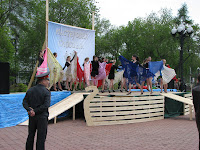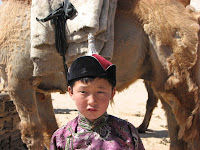
After our time at the lake we were driven to Irkutsk city. We had booked to have a home stay in the city but discovered that all of those who were with us at the lake were going to stay with us at an apartment. The owner of the apartment lived next door and we had the apartment to ourselves. It had 3 bedrooms and a kitchen/dining area and was a short walk from the city centre
The owner took 15 minutes to show us how to lock and unlock the apartment. There was a huge door that needed 3 keys to unlock it. Two of the keys went clockwise while one went anti-clockwise. Once this was opened there was another door that opened with the fourth key. Finally, we had to use an electronic key to open a door to the stairwell. Phew, I have never known anything like it.
The neighbourhood was pretty shabby and unkept but seemed safe enough.
We were disappointed that it was not at all a homestay experience as we expected to spend time with a family and practise some Russian. However, we had a great time with Alex, Spring and Keith.

There were a few old wooden houses left in the city and we were lucky that they were in our neighbourhood. Many have fallen down or been replaced by concrete buildings.

The apartment was on the third floor in this Soviet style block.

We walked about the city to visit the local cathedral, square and war memorial (every town has one, and cities have an eternal flame). We saw many wedding parties as it is customary to visit war memorials on your wedding day to remember those who died for the country. The wedding groups also visit city monuments for photos. The brides wear white or cream and dresses with hooped skirts seem to be the most popular style of dress. The men wear the usual suit. They decorate the cars with balloons, ribbons or plastic flowers and guests carry glasses and bottles of bubbly to celebrate as they wait for the couple.

Lunchtime was a popular time to marry as processions of bridal parties arrived at the most popular sites.

Our guide gave us a city map with internet places marked on it but when she gave it to us she crossed them all out. For some reason, unknown to the locals, the internet places were all closed down. We managed to find a place and there we discovered several people who were on the Trans Siberian train with us so it was a great meeting place.

It was noticeable how many locals drink openly in public. Young men wrapped their bottles of beer in plastic bags but the young girls didn't bother with that. There were lots of older men with swollen faces, scratches, and old and new scars drinking on street corners and in the parks: from falls and fights it appeared. A lot of them looked and smelled like they lived on the street. It is easy to buy alcohol anywhere at any time.
In the evening we ate at a cafeteria. The dishes were all set out and you just pointed to what you wanted. It was priced per 100gms and was weighed and you were charged per gram. They had soup, salad (lots of pickled stuff) and mains of beef, chicken, fish (salmon) and beef. It was nice to have potatoes rather than rice and noodles.
It was noticeable that when we crossed the street, cars blinked their headlights at us and let us cross!
We bought some vodka and had our friends Dee and Derek visit us.

The next day we walked around the city and there was a presentation of diplomas to school children, as well as an exhibition of school projects. This marked the end of the school year and the official holidays for the students.

We visited the huge indoor market and bought some supplies for the next train trip.












































